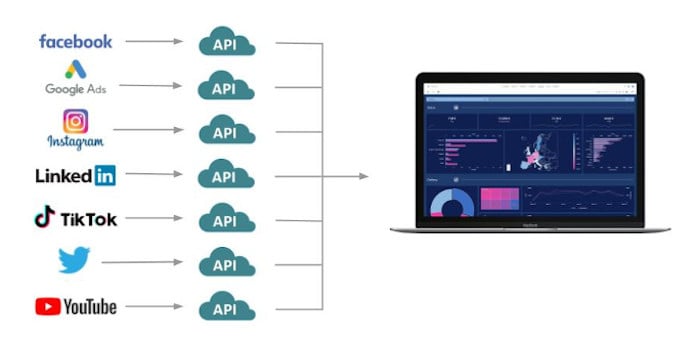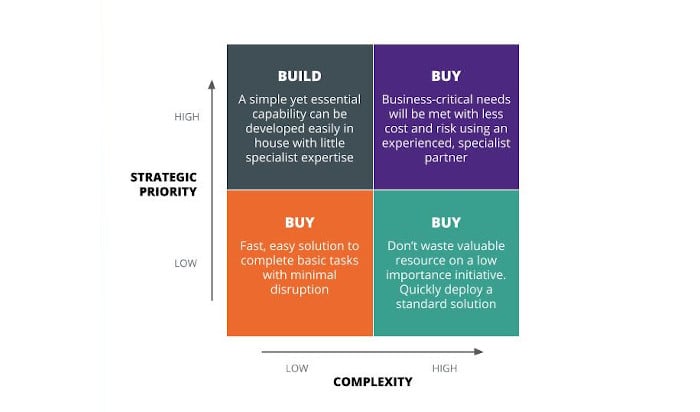Buying a ready-made martech solution or building one tailor-made to your needs? With the strong influx of technology into marketing, this has become a dilemma for many marketers out there. We looked into the pros and cons of both approaches.
Facebook, Instagram, LinkedIn, TikTok, Snapchat, Twitter, YouTube... The choice of social platforms has never been broader, and the customers are loving it. This also means there are more digital touchpoints than ever before, and it’s practically impossible for marketers to report manually and stay competitive.
Combine this with the data from popular advertising platforms such as Google Ads, Bing Ads and Criteo, and the ever-interesting web analytics data about customers visiting your website, and you get into a mess that spins the heads of even the most experienced and tech-savvy marketers.
In order to remain efficient and make the most of the data at their disposal, they need to automate the complex process of gathering and reporting on data from multiple channels. The most effective way you can achieve this by connecting to marketing data sources through their APIs (Application Programming Interfaces). Only then can they get a holistic view on all marketing channels, and understand the relative performances of campaigns by matching data from different sources.

The big question is: do you build your own API connections to these big and complex systems, or buy commercial software with those connectors already built-in? Both options have their pros and cons, so deciding between the two can be hard. Gavin England, Product Marketing Manager at Adverity, brought some clarity on this topic in a recent Adverity Bitesize webinar.
Keeping your customers API
For those unfamiliar with APIs, they’re basically the way platforms such as Facebook or Twitter make data securely accessible to external applications. As a result, you can get a wealth of information from Facebook or Google Ads, helping you to fully understand your marketing performance on those channels.
However, accessing APIs is just the start, says Gavin. Once you have connected to these networks through their APIs and collected the data, it then needs to be harmonized in such a way that you can compare the information from all the different channels. When this is done and the data is ready to be analyzed, the solution you are using needs the ability to offer you an effective cross-channel analysis. The best way to achieve this is through visual charts and dashboards, that make it easy for you to understand the results of your marketing campaigns, trends and KPIs.
To build or to buy, that is the question?
So, do you build or buy? To answer this Gavin suggests asking key questions that include: does building your own solution provide you with a competitive advantage? Do you have the available IT resources that can develop and maintain such a system? Will they know how to map the data fields required to transform collected data, create dashboards and reports for users, and ensure the interface is user-friendly enough?
Also, there are additional questions that need to be answered. Do you want to analyze a few channels in your campaigns, or a much larger number? If you’re just looking to analyze, for example, only Amazon marketplace and ads data, it could be feasible to build your own solution, Gavin suggests. But in a majority of other cases, this would be a huge challenge, even for larger organizations.
Strategic priority and complexity considerations
Another set of considerations that will help with the ‘build versus buy’ decision involves how strategically important such a system would be to your marketing reporting and optimization, and how complex your digital marketing ecosystem is. As a rule of thumb, if a simple, yet essential capability can be developed easily in-house, with little specialist expertise, and your system complexity is low, while it’s a high strategic priority, then you should build.

However, Gavin says, if it’s not a high strategic priority, and regardless of whether your digital marketing ecosystem is complex or not, you ought to buy an already commercially available product. Building an API-centric automated data analytics platform in-house can be complex and expensive.
Equally, if it’s strategically very important for you to have a complete oversight on marketing performance, but your marketing tools stack is complex and you require a high level of automation, it’s better to buy and benefit from the expertise and IT sophistication of a partner organization. They can also help you to optimize the analytics platform you purchased, so it works exactly how you need it to. After all, there’s no point buying a Ferrari and keeping in the garage.









